Smartphone Camera Lens Market Size
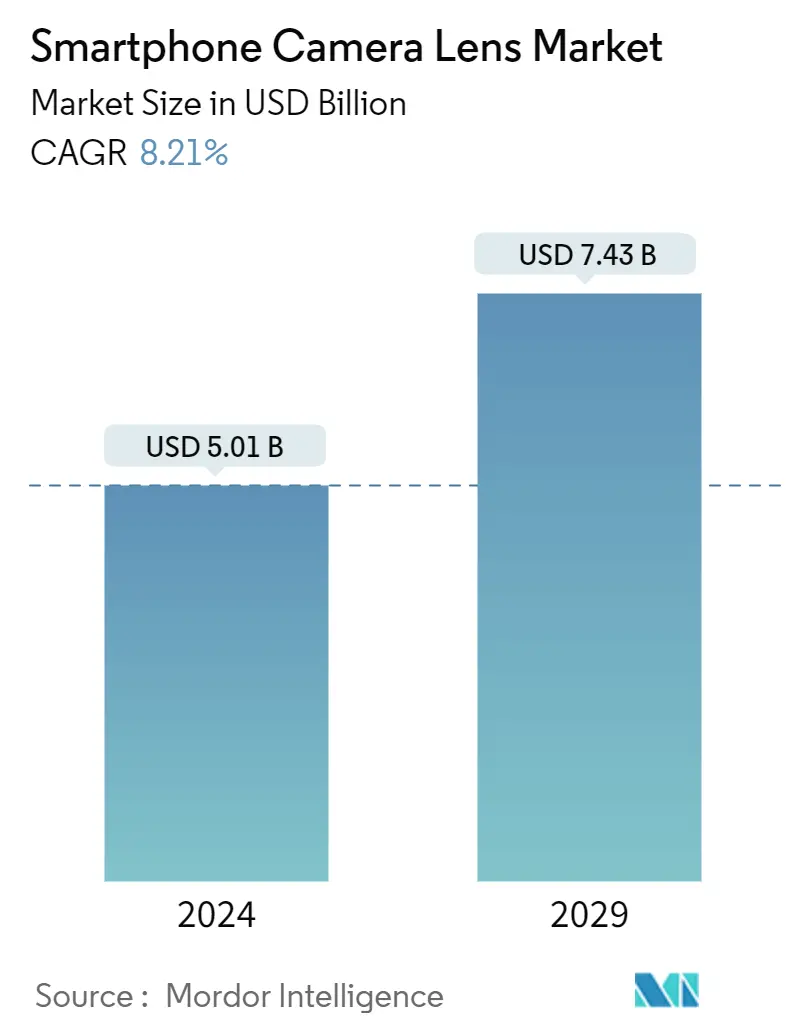
| Study Period | 2019-2029 |
| Market Size (2024) | USD 5.01 Billion |
| Market Size (2029) | USD 7.43 Billion |
| CAGR (2024 - 2029) | 8.21 % |
| Fastest Growing Market | Asia Pacific |
| Largest Market | Asia Pacific |
Major Players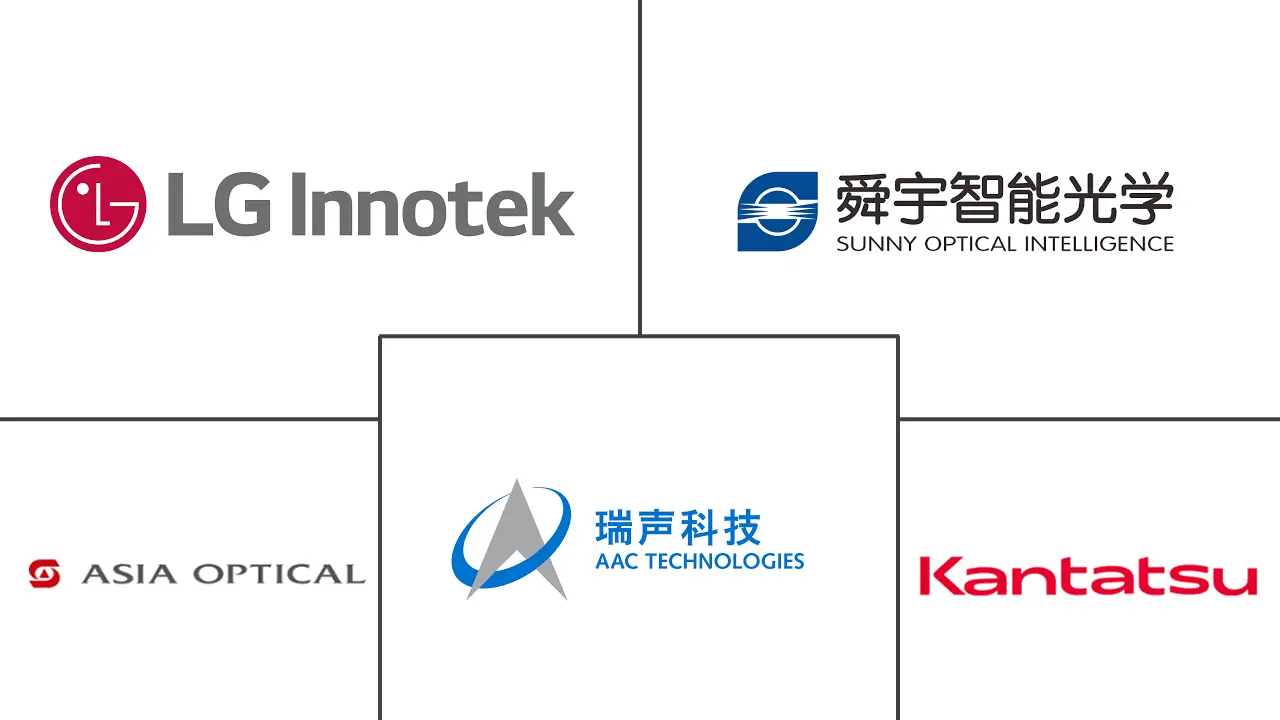
*Disclaimer: Major Players sorted in no particular order |
Smartphone Camera Lens Market Analysis
The Smartphone Camera Lens Market size is estimated at USD 5.01 billion in 2024, and is expected to reach USD 7.43 billion by 2029, growing at a CAGR of 8.21% during the forecast period (2024-2029).
The market is witnessing various advancements related to the different types of lenses being used in smartphones. Various smartphone manufacturers are developing smartphones with multiple cameras that include other types of lenses, including telephoto lenses, macro lenses, and ultra-wide-angle lenses.
- The lenses of smartphone cameras refer to the optical components integrated into the camera modules of smartphones. These lenses combine with sensors and image-processing algorithms to capture photos and videos. A single lens typically comprises multiple glass or plastic elements arranged in a specific configuration to achieve the desired optical performance. Combining multiple lenses with different focal lengths and functionalities helps smartphone users capture a wide range of images without using external attachments.
- With rapidly increasing technological developments in smartphones, the adoption of camera lenses has been continuously rising, thereby pushing the market players to invest in this technology through product innovations, expansion activities, mergers, acquisitions, collaborations, and partnerships. For instance, in January 2023, Samsung Electronics announced the launch of its latest image sensor, the ISOCELL HP2, which entails a 200-megapixel resolution. According to Samsung, the lens will offer improved pixel technology for better image quality in its premium smartphones.
- Growing regional economies and rising disposable incomes in emerging markets have led to a surge in the global demand for smartphones. With each new generation of smartphones, there are new advancements in the capabilities of the cameras. Consumers increasingly prioritize the quality of a phone's camera while purchasing a new one. Thus, manufacturers are investing in improving the performance of camera lenses in mobile phones.
- Over the recent years, the smartphone market has witnessed a decline in sales. Several factors have contributed to this decline, including reduced demand from customers, economic uncertainties, and global inflation.
- The outbreak of the COVID-19 pandemic has left a notable dent in the market as various containment measures taken by governments across multiple countries, such as the implementation of lockdowns, significantly impacted the growth of the industry. As a result, a slowdown was witnessed in the market, especially during the initial phase of the pandemic. The COVID-19 pandemic impacted the global sales of smartphones. This situation also posed several challenges to the industry. Lockdowns and economic uncertainties led to consumers spending less on non-essential products, thereby resulting in a decrease in the demand for smartphones.
Smartphone Camera Lens Market Trends
Increasing Popularity of Multiple Camera Smartphones and the Introduction of Advanced Camera Technologies will Drive the Market
- Smartphones are being continuously updated with the incorporation of the latest technologies. A central selling point of new smartphones is often a new and improved camera. This feature generates heavy demand to improve this hardware technology on a continuous basis. Nowadays, people are more focused on clicking pictures on their phones instead of using conventional cameras for the same.
- As artificial intelligence continues to advance, smartphones are witnessing innovations, including the emergence of multiple cameras. With the introduction of smartphones, when multi-camera smartphones gained enormous market traction, many brands began to introduce quad-camera or five-camera models. Multiple cameras in smartphones have enabled the development of new features, such as zoom, better HDR (high dynamic range), portrait modes, 3D options, and low-light photography options.
- The lens market is also witnessing the development of several advanced camera technologies. For instance, the night mode feature enables users to capture high-quality photos in low-light conditions. It uses advanced algorithms and image processing techniques to reduce noise and enhance details, thereby resulting in brighter and clearer images.
- Optical image stabilization, computational photography, and AI-powered camera features, like optimizing camera settings and enhancing image quality by adjusting exposure, color, and other parameters, are also likely to drive the demand for better lenses.
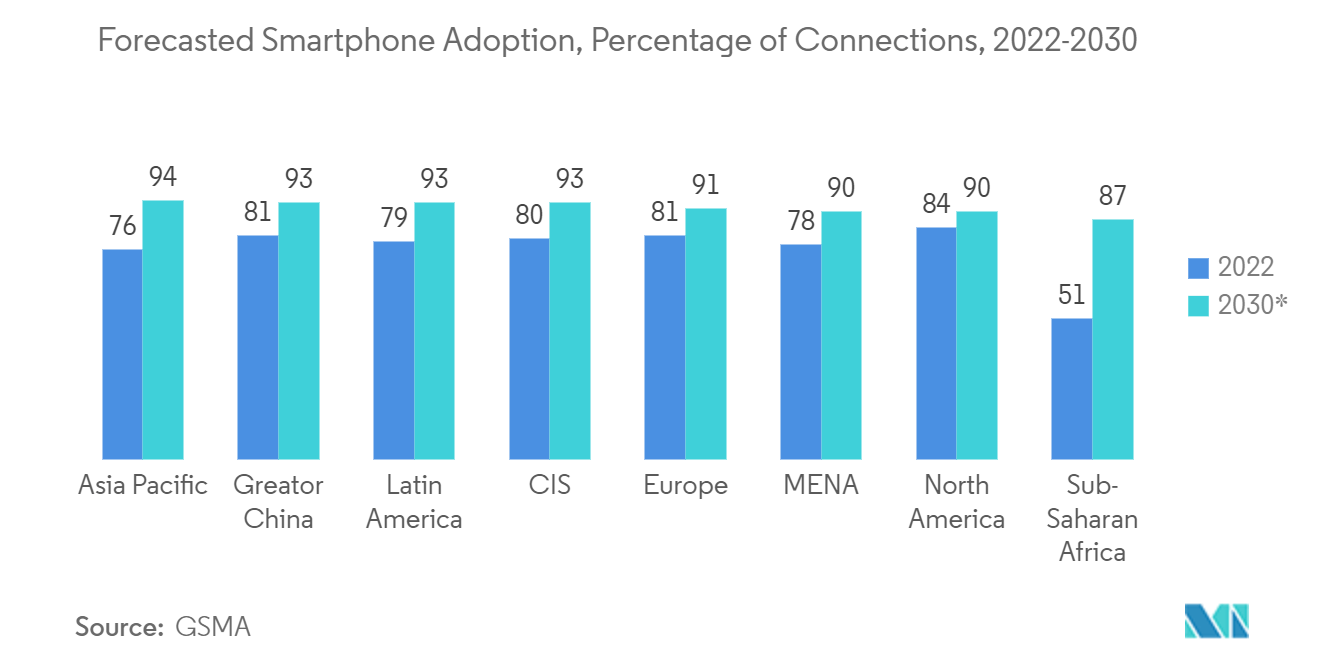
Asia-Pacific will Witness Significant Growth
- The Asia-Pacific region is a significant hub for smartphone manufacturing activities, which require a steady supply of camera lenses. Consumers in the region are showing an increased preference for smartphones with high-resolution cameras for capturing photos and videos. This growth in demand is leading to an increased need for advanced camera lenses for smartphones.
- The Asia-Pacific region has been one of the most significant markets for smartphones, primarily due to the highly developing telecom sector and the large customer base. According to the National Bureau of Statistics of China, in 2022, the production volume of smartphones in China was almost 1.6 billion units. China was the world's largest smartphone producer in 2022. In 2021 and 2020, the recorded volumes of smartphone production were 1.67 units and 1.47 billion units, respectively. According to IBEF, India is one of the leading exporters of cell phones. The country aims to produce electronics worth USD 300 billion by FY 2026. Manufacturing smartphones would be the key to achieving this ambitious goal.
- The region is increasingly investing in advanced mobile networks. Countries like China, India, Japan, Australia, Singapore, and South Korea are increasingly investing in developing their domestic telecom markets. This move is expected to drive the market in the region. The availability of raw materials and the low costs of establishment and labor have also motivated many companies to establish their production centers in the Asia-Pacific region.
- The growing demand for smartphones and other electronic products in countries such as India, China, the Republic of Korea, and Taiwan is encouraging many companies to set up their factories in the Asia-Pacific region. For instance, OPPO, a global smartphone and device brand, recently established a smartphone manufacturing unit in India.
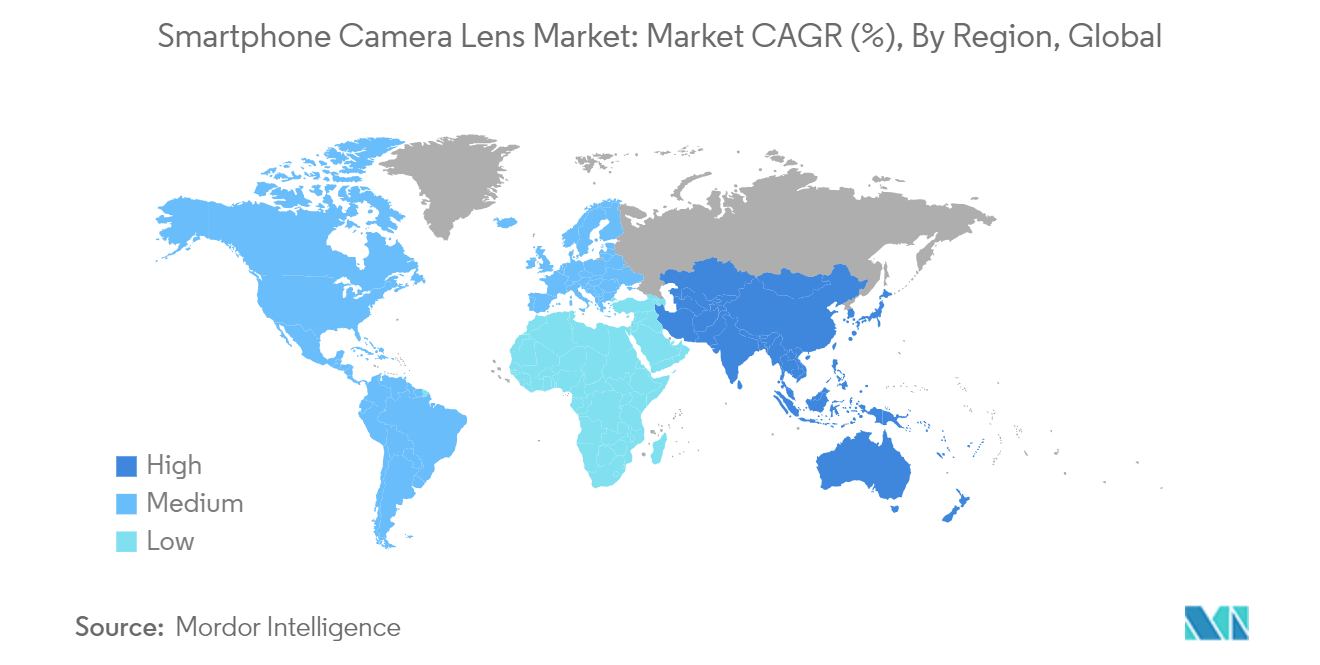
Smartphone Camera Lens Industry Overview
The smartphone camera lens market is fragmented due to the presence of many large and small players. Some of the major players are LG Innotek, Sunny Optical Technology (Group) Company Limited, Asia Optical Co. Inc., AAC Technologies, and Kantatsu Co. Ltd (Sharp Corporation). These companies keep innovating new products and entering strategic partnerships with other firms to retain their market shares.
- June 2023 - LG Innotek announced an investment worth USD 995 million in its Hai Phong production subsidiary in Vietnam to expand its camera module production line. The purpose of the investment is to expand the production capacity of specific camera modules, such as the camera module of Apple's iPhone. The construction of the new plant in Vietnam is expected to be completed in the second half of 2024, and it will start mass production in 2025.
- April 2023 - Genius Electronic Optical (GSEO) focuses on developing innovative products and solutions. The company recommends suppliers wherever improvements are needed and monitors their implementation processes. The company was named by industry sources as a potential supplier for the upcoming iPhone series in 2023, which included periscope lenses.
Smartphone Camera Lens Market Leaders
-
LG Innotek
-
Sunny Optical Technology (Group) Company Limited
-
Asia Optical Co. Inc.
-
AAC Technologies
-
Kantatsu Co. Ltd (Sharp Corporation)
*Disclaimer: Major Players sorted in no particular order
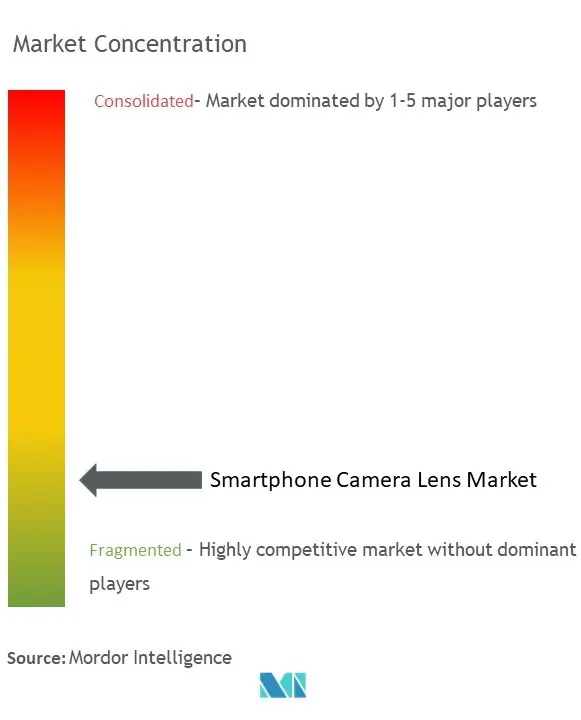
Smartphone Camera Lens Market News
- October 2023 - Google launched its Pixel 8 series. It uses AI algorithms to pick out the best facial expressions in batches of group photos and easily paste them into a different image template. Samsung also applied around 60 AI models for the functions of the cameras on its Galaxy S22 Ultra, thereby allowing customers to click detailed close-up photos of night scenes and match the quality of a DSLR.
- April 2023 - The smartphone brand OnePlus expanded its Nord series in India with the launch of the OnePlus Nord CE 3 Lite. This model has triple camera sensors on the back. Four-camera modules for smartphones have also been gaining increasing popularity, with many players launching quad-camera smartphones.
Smartphone Camera Lens Market Report - Table of Contents
1. INTRODUCTION
- 1.1 Study Assumptions and Market Definition
- 1.2 Scope of the Study
2. RESEARCH METHODOLOGY
3. EXECUTIVE SUMMARY
4. MARKET INSIGHTS
- 4.1 Market Overview
-
4.2 Industry Attractiveness - Porter's Five Forces Analysis
- 4.2.1 Bargaining Power of Suppliers
- 4.2.2 Bargaining Power of Buyers
- 4.2.3 Threat of New Entrants
- 4.2.4 Threat of Substitute Products
- 4.2.5 Intensity of Competitive Rivalry
- 4.3 Impact of COVID-19 Aftereffects and Other Macroeconomic Factors on the Market
5. MARKET DYNAMICS
-
5.1 Market Drivers
- 5.1.1 Increasing Popularity of Multiple Camera Smartphones and the Introduction of Advanced Camera Technologies
-
5.2 Market Restraints
- 5.2.1 Slow Down of Smartphone Sales and Increasing Pricing Competition
6. MARKET SEGMENTATION
-
6.1 By Geography
- 6.1.1 Asia-Pacific
- 6.1.2 Americas
- 6.1.3 Europe
- 6.1.4 Rest of the World
7. COMPETITIVE LANDSCAPE
- 7.1 VENDOR RANKING ANALYSIS
-
7.2 Company Profiles
- 7.2.1 LG Innotek
- 7.2.2 Sunny Optical Technology (Group) Company Limited
- 7.2.3 Asia Optical Co. Inc.
- 7.2.4 AAC Technologies
- 7.2.5 Kantatsu Co. Ltd (Sharp Corporation
- 7.2.6 SEKONIX Co. Ltd
- 7.2.7 Genius Electronic Optical (GSEO)
- 7.2.8 Largan Precision Company Limited
- 7.2.9 Kinko Optical Co. Ltd
- 7.2.10 Haesung Optics Co. Ltd
- 7.2.11 Ofilm Group Co. Ltd
- 7.2.12 Samsung Electro-Mechanics Co. Ltd
- *List Not Exhaustive
8. INVESTMENT ANALYSIS AND OPPORTUNITIES
** Subject To AvailablitySmartphone Camera Lens Industry Segmentation
A smartphone camera lens is an optical lens or an assembly of lenses used in association with a camera body that is meant for a smartphone. It has the mechanism to make images of objects either on a photographic film or on other media capable of chemically or electronically storing an image. A lens plays a crucial role in image quality and versatility, thereby allowing users to capture diverse shots ranging from wide landscapes to portraits with close-up details.
The smartphone camera lens market is segmented by geography (Asia-Pacific, Americas, Europe, and Rest of the World). The market size and forecasts of all the above segments are provided in terms of their respective values (in USD).
| By Geography | Asia-Pacific |
| Americas | |
| Europe | |
| Rest of the World |
Smartphone Camera Lens Market Research FAQs
How big is the Smartphone Camera Lens Market?
The Smartphone Camera Lens Market size is expected to reach USD 5.01 billion in 2024 and grow at a CAGR of 8.21% to reach USD 7.43 billion by 2029.
What is the current Smartphone Camera Lens Market size?
In 2024, the Smartphone Camera Lens Market size is expected to reach USD 5.01 billion.
Who are the key players in Smartphone Camera Lens Market?
LG Innotek, Sunny Optical Technology (Group) Company Limited, Asia Optical Co. Inc., AAC Technologies and Kantatsu Co. Ltd (Sharp Corporation) are the major companies operating in the Smartphone Camera Lens Market.
Which is the fastest growing region in Smartphone Camera Lens Market?
Asia Pacific is estimated to grow at the highest CAGR over the forecast period (2024-2029).
Which region has the biggest share in Smartphone Camera Lens Market?
In 2024, the Asia Pacific accounts for the largest market share in Smartphone Camera Lens Market.
Smartphone Camera Lens Industry Report
Statistics for the 2024 Smartphone Camera Lens market share, size and revenue growth rate, created by Mordor Intelligence™ Industry Reports. Smartphone Camera Lens analysis includes a market forecast outlook to for 2024 to 2029 and historical overview. Get a sample of this industry analysis as a free report PDF download.



